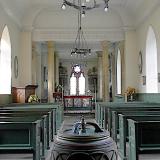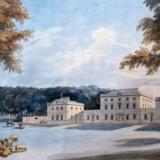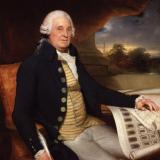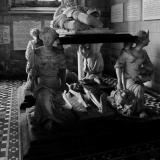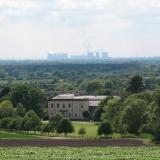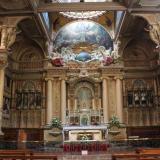Georgian Architecture in East Yorkshire
The Georgian era is most apparent to us in its architecture. The surviving buildings are there to proclaim the style of the period whether people look for it or not. There are plenty of survivals in the region: from country houses, and the impressive civic buildings of Beverley and Hull, to the many surviving Georgian houses large and small.
Particularly treasured are surviving Georgian interiors, which are more susceptible to updating as people modified their decor to suit their changing tastes and needs. Many of these, like the plasterwork ceiling of the Neptune Inn in Hull, are normally locked away behind closed doors, but can often be seen during pre-arranged visits or on Heritage Open Days.
An Outing to East Yorkshire’s Georgian Churches
East Yorkshire has few Georgian churches. It has lost most of what the dark genius of Nicholas Hawksmoor gave Beverley Minster: his high organ screen; his lofty reredos; his elegant pulpit - all replaced by workmanlike, less sensational substitutes - and, saddest loss of all, his central dome, dark, wholly original, ingenious, for which no substitute has ever been ... (read more...)
Building a Georgian Country House – Dalton Hall, South Dalton
In 1705-6 Scorborough Hall, the seat of the Hotham family since the 14th century, was burnt down. The family of Sir Charles Hotham, 4th Bt, were now homeless and, after many years in rented houses in Bishop Burton and Hull, Sir Charles decided to build a house in Beverley. This was the grand mansion on Eastgate, built 1716-23, to ... (read more...)
John Carr of York - Architect (1723 -1807)
by FRANCIS F. JOHNSON F.S.A. The recent exhibition in the Ferens Art Gallery devoted to John Carr has not only done timely honour, but focused attention on his important and fascinating career. Unlike many figures of the past, Carr's reputation has never fallen into complete oblivion; however, although many have written about him, we still await a definitive biography. ... (read more...)
The Mystery of The Missing Foot
This morning the following letter fell out of a book as I took it from the shelf. I had never seen the letter before. It was dated 19th February 1943, and was from the 6th Lord Hotham at Dalton Hall to Mrs Arundell Esdaile. "Thank you for your letter. The skeleton was for many years kept in a coffin-like ... (read more...)
The Restoration of the Wrought Iron Balustrade of MAISTER HOUSE The High Street, Kingston upon Hull
By ALAN K. BRAY R.I.B.A. (writing in 1975) In early 1971 it was decided by the National Trust that the wrought iron balustrade at Maister House was in need of comprehensive repair and redecoration. This fine ironwork by Bakewell, after 227 years of service appeared at a first glance still in reasonable condition. Close inspection revealed that while the ... (read more...)
The Restoration of BLAYDES HOUSE and it’s Particular Problems
By ALAN K. BRAY R.I.B.A. (writing in 1975) Many buildings, during their lifetime, sometimes extending through hundreds of years, survive a variety of changes. These might be changes of use, structural alterations and additions, improvements (or so considered by their owners) repair works resulting in some change in appearance, changes in the external environment by development of the area ... (read more...)
Blaydes House, Hull
Blaydes House was built in around 1740 for the Blaydes family as their home and business premises. The property was rescued, by our own society and then sold to Hull University for £1. (read more...)
Burton Agnes Hall, East Yorkshire
This Elizabethan House was described by Simon Jenkins as "the perfect English house". Aside from its Elizabethan plasterwork and joinery the house contains an impressive art collection. http://www.burtonagnes.com/Home.html (read more...)
Burton Constable Hall Stables, East Yorkshire
The Stables at Burton Constable Hall were built in 1770 to the designs of Timothy Lightoler. The scale of the blocks reflects the Clifford Constable families love of riding. There were two stable blocks: the most architecturally sophisticated housed the hunters while the draught horses had a plainer building. The grooms slept on the upper floors. A large indoor ... (read more...)
Burton Constable Hall, East Yorkshire
The site of Burton Constable was first occupied by a mediaeval pele tower. This was rebuilt as a brick house in the early Tudor period and further developed as a grand Elizabethan mansion by Sir John Constable in the 1560s. The interiors were remodelled in a variety of Georgian idioms in the eighteenth century, most notably by Timothy Lightoler ... (read more...)
Church of Saint Mary the Virgin, Cottingham, East Yorkshire
The oldest parts of the Cottingham's parish church date from the early fourteenth century; the west window exhibits the flowing lines of the Curvilinear style favoured by Yorkshire masons at that time. The manor of Cottingham was owned by Joan 4th Countess of Kent; after she married the Prince of Wales (Edward the Black Price) in 1361, the church ... (read more...)
Escrick Hall
Situated south of York, in what was historically the East Riding of Yorkshire but is now officially North Yorkshire, Escrick Hall stands on the site of a mediaeval house whose cellars still exist below the floors. The present house was built for Henry Thompson (1659–1700), MP for Hedon, in the last decades of the seventeenth century. The seventeenth century ... (read more...)
Holme Hall, Holme on Spalding Moor, East Yorkshire
Built in the 1660s for Lord Lngdale, Holme Hall was extended in the 1720s and again circa 1760. It has fine Georgian internal features and a Roman Catholic chapel of 1766 attributed to John Carr. The home of the Stourton samily in the 19th century, it was a convent from 1929 until the 1970s. It is now a Sue ... (read more...)
Kilnwick Percy Hall, near Pocklington, East Yorkshire
Like a lot of country houses, the earliest occupation of the site stretches back into the mists of time. In 1574 Thomas Wood began a grand Elizabethan House here, but it was unfinished at the time of his death ten years later. The houses was only finished in the 1720s when the estate passed to Sir Edmund Anderson. Anderson's ... (read more...)
Maister House, Hull
The building's sober facade hides one of the most fascinating interiors in the city; and a story of wealth, tragedy and high art. The wealth belonged to the Maister family. The Maisters were one of a number of merchant families who lived on Hull's High Street and traded with ports around the North Sea and Baltic. The family originated ... (read more...)
Sewerby Hall, Bridlington, East Yorkshire
A fine example of the eary Georgian period, this Grade I listed house has recently undergone a £2.6 million renovation, opening many more rooms to the public. It contains two rooms of Amy Johnson memorabilia. The award winning gardens include a walled garden, rose beds and a pleasue garden with magnificent Monkey Puzzle trees. (read more...)
Sledmere House, East Yorkshire
The original Sledmere house of 1751 forms the core of the more substantial house of the created in the 1790s. The neoclassical design by Samuel Wyatt and Sir Christopher Sykes, 2nd Baronet, is characterised by the repeated use of an unusual motif of arched recesses framing tripartite windows. After the house was badly damaged by a fire in 1911, ... (read more...)
Southwood Hall, Cottingham, East Yorkshire
Now surrounded by twentieth century developments, Southwood Hall is a remarkably intact example of a late seventeenth century house. It was built sometime before 1661 for the Bacchus family and was later a tenanted farmhouse; few alterations have been made since the eighteenth century. The house displays the bold decorative brick work typical of the seventeenth century. The present ... (read more...)
St Charles Borremeo, Jarratt Street, Hull
The Roman Catholic Church of St Charles Borremeo was designed by John Earle junior and built 1828-9, with substantial enlargements in 1835. The classical interior was greatly enriched by an overlay of baroque style decoration in the 1890s. The church was listed Grade I in 2015 and has undergone extensive restoration. The Church is open daily for mass. Guided ... (read more...)
St Mary's Church, South Dalton, East Yorkshire
The church of St Mary was designed by John Loughborough Pearson and built 1858-61 as a replacement for a brick structure. Its spire is over 200 feet (61 m) tall. Inside the church lie a number of the Hotham family; the older monuments were transferred from the earlier church. There is a fine black and white marble monument in ... (read more...)
St Oswald's Church, Hotham, East Yorkshire
Norman in origin with a short west tower of the early 12th century and one Early English window in the nave. The chancel was rebuilt 1904-5 by the Hull architect F.S. Brodrick. Of particular note is the early 19th-century extension on the north side of the nave, built to house the squire's pew. An external door leads to a ... (read more...)
Wassand Hall, East Yorkshire
Wassand Hall dates from 1813 and was designed by Thomas Cundy for Rev Charles Constable. The house was restored by Francis Johnson in 1947 and its Regency interiors remain largely intact. There are two walled gardens; one contains roses whilst the other is a kitchen garden. http://wassand.co.uk/ (read more...)
In this section
- The Georgians
- Georgian Architecture in East Yorkshire
- Georgian Art, Literature & Music in East Yorkshire
- Georgian Science, Industry & Commerce in East Yorkshire
- Georgian Politics, Diplomacy & War
Related Products
- A New Picture of Georgian Hull, by Ivan & Elisabeth Hall
- Georgian Architecture & The Georgian Society for East Yorkshire, by Austen Redman & David Neave
- Landscape Parks and Gardens of East Yorkshire 1700-1830, by David Neave & Deborah Turnbull
See also
- John Carr of York - Architect (1723 -1807)
- The Restoration of the Wrought Iron Balustrade of MAISTER HOUSE The High Street, Kingston upon Hull
- The Restoration of BLAYDES HOUSE and it’s Particular Problems
.jpg)
